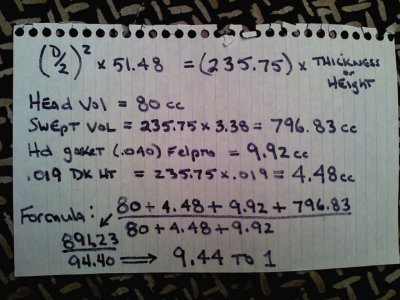RRSweden
Well-Known Member
I just measured the piston-to-deck-clearance and got .080 on my 383 block. Stock rods and SP ( 366AP30) flat top pistons. I'm using 906 heads (measured 88cc) and the Felpro head gasket ( 8519PT-1 ) wich after some googling is said to be .040 compressed.
Block is .030 bore.
All these parameters gives a compression ratio of 8.13:1
The service manual for 1970 says 9.5:1 compression ratio, and that's without the .030 bore. And as far as I know I'm prette close to stock with this setup...
What's your thoughts, and how could i crank the ratio up?
Block is .030 bore.
All these parameters gives a compression ratio of 8.13:1
The service manual for 1970 says 9.5:1 compression ratio, and that's without the .030 bore. And as far as I know I'm prette close to stock with this setup...
What's your thoughts, and how could i crank the ratio up?

















